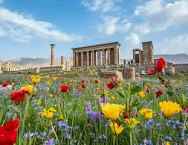Celebrating the Nowruz festival in the northern provinces
Mila Nowrozi is one of the important and traditional festivals in Afghan culture, which is celebrated in the spring and on the occasion of the beginning of the new year (Nowruz). This festival is also celebrated in the northern provinces of Afghanistan with joy and enthusiasm and has its own ceremonies and customs. In these northern provinces of Afghanistan, which include provinces such as Balkh, Baghlan, Samangan and Takhar, this festival is celebrated in a special way:
-
Decoration of houses and places: In these provinces, people especially on Nowruz days, decorate houses and public places with Nowruz sticks (squirrels) and colorful flowers and flags. These decorations together with the sounds of local music and traditional songs create special performances.
-
Holidays and Public Ceremonies: In the northern provinces, public holidays are declared on the days of Nowruz and the Eid celebrations, and people gather for celebrations and public ceremonies. These celebrations include dances, poetry readings, local games and various sports competitions.
-
Cooking of traditional foods: In these celebrations, traditional Afghan foods such as samosas, ash, rice, kebabs and other foods along with sweets and special foods form the tables. These foods are served as a symbol of happiness and the end of winter and the beginning of new spring in Nowruz.
-
Tradition and local culture: These celebrations in the northern provinces of Afghanistan are an opportunity to celebrate the traditions and local culture of these areas. People use their culture by wearing traditional clothes, performing local dances and songs, displaying traditional arts and presenting various ceremonies.
In general, the Nowruz festival in the northern provinces of Afghanistan is an important and happy celebration with local cultural colors and aromas, welcoming the spring season and the beginning of the new year, and bringing a special color and fragrance to the environment of the northern part of Afghanistan.

Bozkshi in the new year
Bozkashi is one of the traditional and popular ceremonies in Afghanistan on Nowruz (New Year) days, which is also called “Bazkashi” or “Bazbanki”. This ceremony is celebrated with enthusiasm in some parts of Afghanistan, especially in villages and small towns. In this ceremony, groups of young people and common people act and go to the streets by pulling a pole (decorated in the shape of a goat or banghai) and ask for permission to pass.
This ceremony is a symbol of the beginning of the new year and the end of winter and is usually held on the last days of the lunar year (Nina) or the first days of the new year. People who pull the pole are known as representatives of good luck for the new year by painting their faces and wearing colorful clothes.
In Bozkashi in addition to games and merriment, people usually benefit from alms and cash gifts that are distributed publicly on these days. This ceremony is also an opportunity for people to socialize with each other and exchange greetings for the new year.
In general, Mila Bazkashi is a lively and lively traditional ceremony, which is especially welcomed in Afghanistan as an important part of Nowruz and New Year celebrations, and it is a condolence for the end of winter and the beginning of spring and Nowruz.

In the new year, in most provinces, people celebrate Mila Bazkashi
It’s true, Mila Bazkashi or Bazbanki is one of the traditional and popular ceremonies celebrated in most provinces of Afghanistan on Nowruz (New Year) days. This ceremony is of special interest as a symbol of joy and happiness for the beginning of the new year and the beginning of spring and is performed in most parts of Afghanistan, especially in villages and small towns.
Mila Bazkashi ceremony may be held in different provinces with different details and traditions, but basically this ceremony includes the following:
-
Acting and decorations: In this ceremony, groups of young people and people go to the streets with colorful clothes and faces and colorful decorations. They usually carry a pole (decorated in the shape of a goat or bangs).
-
Reception and Music: During the ceremony, people play and dance and enjoy local music and traditional songs. Also, on these days, traditional Afghan dishes such as samosa, ash, rice, etc. along with special sweets are on the tables.
-
Holidays and Greetings: The goat bar is usually associated with public holidays and people are known as representatives of happiness and good fortune for the new year. On these days, people take the opportunity to congratulate and exchange New Year greetings.
Therefore, Mila Bazkashi is celebrated as an important and passionate event throughout Afghanistan on the days of Nowruz and represents the joy and happiness of the people for the beginning of the new year and the spring season.

Celebrating Nowruz during the Taliban rule
During the Taliban rule in Afghanistan, the Nowruz (New Year) celebration and its related ceremonies were influenced by the policies of this group, and there may be restrictions and obstacles for holding the traditional ceremonies of this celebration. According to their religious interpretation, the Taliban are concerned about some traditions and popular celebrations, and restrictions may be proposed for holding public ceremonies on these days.
During the Taliban rule, the permission to hold popular and traditional Nowruz celebrations in some areas and for some people was severely limited. It is possible that depending on the political and military conditions and the special regulations announced by the Taliban at that time, people have less freedom to hold traditional Nowruz ceremonies.
But with the recent changes and after the end of the Taliban rule, the people of Afghanistan may have started celebrating and holding traditional Nowruz ceremonies more than before. This can be seen as a symbol of freedom and normal life for the people of Afghanistan who, after years of sanctions and restrictions, are now able to hold their traditional celebrations and holidays.